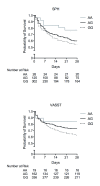IL17A genetic variation is associated with altered susceptibility to Gram-positive infection and mortality of severe sepsis
- PMID: 22026963
- PMCID: PMC3334805
- DOI: 10.1186/cc10515
IL17A genetic variation is associated with altered susceptibility to Gram-positive infection and mortality of severe sepsis
Abstract
Introduction: Interleukin 17A (IL17A) plays a key role in host defense against microbial infection including Gram-positive bacteria. Genetic factors contribute to the host defense, but the role of IL17A single nucleotide polymorphisms (SNPs) has not yet been investigated in severe sepsis. Therefore, we hypothesized that SNPs in the IL17A gene alter susceptibility to infection and clinical outcome of severe sepsis.
Methods: We tested for the association of IL17A SNPs with susceptibility to infection and clinical outcome of severe sepsis using two cohorts of European ancestry (derivation cohort, St Paul's Hospital (SPH), n = 679; validation cohort, Vasopressin and Septic Shock Trial (VASST), n = 517). The primary outcome variable was susceptibility to Gram-positive bacterial infection. The secondary outcome variable was 28-day mortality.
Results: Of four tested IL17A tag SNPs (rs4711998, rs8193036, rs2275913, rs1974226), rs1974226 SNP was associated with altered susceptibility to Gram-positive infection in the derivation SPH cohort (corrected P = 0.014). Patients having the rs1974226 GG genotype were more susceptible to Gram-positive infection, compared to AG/AA genotype in the two cohorts of severe sepsis (SPH, P = 0.0036, odds ratio (OR) 2.19, 95% confidence interval (CI) 1.28-3.72; VASST, P = 0.011, OR 1.95, 95%CI 1.16-3.27) and in the subgroup having lung infection (P = 0.017, OR 1.90, 95%CI 1.12-3.21). Furthermore, the IL17A rs1974226 G allele was associated with increased 28-day mortality in two cohorts (SPH, adjusted OR 1.44, 95%CI 1.04-2.02, P = 0.029; VASST, adjusted OR 1.67, 95%CI 1.17-2.40, P = 0.0052).
Conclusions: IL17A genetic variation is associated with altered susceptibility to Gram-positive infection and 28-day mortality of severe sepsis.
Figures



References
-
- Cho JS, Pietras EM, Garcia NC, Ramos RI, Farzam DM, Monroe HR, Magorien JE, Blauvelt A, Kolls JK, Cheung AL, Cheng G, Modlin RL, Miller LS. IL-17 is essential for host defense against cutaneous Staphylococcus aureus infection in mice. J Clin Invest. 2010;120:1762–1773. doi: 10.1172/JCI40891. - DOI - PMC - PubMed
-
- Hamada S, Umemura M, Shiono T, Tanaka K, Yahagi A, Begum MD, Oshiro K, Okamoto Y, Watanabe H, Kawakami K, Roark C, Born WK, O'Brien R, Ikuta K, Ishikawa H, Nakae S, Iwakura Y, Ohta T, Matsuzaki G. IL-17A produced by gammadelta T cells plays a critical role in innate immunity against listeria monocytogenes infection in the liver. J Immunol. 2008;181:3456–3463. - PMC - PubMed
Publication types
MeSH terms
Substances
Grants and funding
LinkOut - more resources
Full Text Sources
Medical

